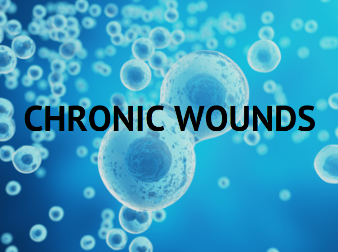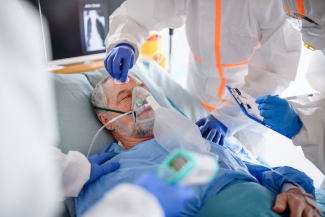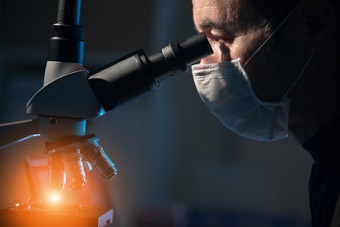Chronic Wound Factors and Management Strategies
November 1, 2017
What is a chronic wound? What changes must happen within a wound for clinicians to classify it as "chronic"? Is there a time frame for healing chronic wounds? And what should we clinicians do to prevent and/or reverse chronic wounds? These are all great questions that keep us on our toes, from the dedicated seasoned clinician to the clinicians new to our field. In this blog I will define what a chronic wound is, what it consists of, and whether there is a way to convert or reverse a wound.
By definition, a chronic wound is a wound that has "failed to proceed through an orderly and timely process to produce anatomical and functional integrity, or proceeded through the repair process without establishing, a sustained anatomic and functional result."1 In layman's terms, a chronic wound is a wound that does not proceed through the four phases of wound healing in an orderly fashion and decides to make one too many pit stops through the journey.
Breaking Down the Chronic Wound
First of all, who is called when a difficult, stubborn, chronic wound arises? That's right guys—us! The SWAT team (skin wound assessment team) comes to the rescue. To start off, an acute wound is one that heals in a sequential and orderly fashion; the overlapping in the phases of wound healing proceeds with the correct cellular response, coordination, and activity, making all run smoothly and uninterrupted and achieving closure. So what happens in the case of chronic wound with cellular activity? Systemic factors allow for local factors and chronic diseases to cause a cascade of events that regress and halt the healing process.. Characteristics include:
- Non-healing wound greater than four weeks
- Frail tissue to wound bed and edges
- Non-robust granular tissue
- Wounds that often become stalled in the inflammatory or proliferative phase of wound healing
Other Factors Contributing to Chronic Wounds
- Chronic conditions such as end-stage renal disease, diabetes mellitus (hemoglobin A1c >7), congestive heart failure, peripheral vascular disease, peripheral artery occlusive disease, liver failure
- Infections: wound, influenza, systemic, hepatitis
- Autoimmune and hematological disorders
- Steroids
- Chemotherapy
- Malnutrition – kwashiorkor/marasmus, vitamin and mineral deficiency
- Alcohol and tobacco abuse
- Repeated trauma – pressure, friction, and shear
- Malignancies to wound
- Topical antiseptics – iodine, hydrogen peroxide, Dakin's solution, etc.
- Biofilm – research indicates that more than 60% of chronic wounds develop a biofilm
Cellular Activity of the Chronic Wound
- Colonization to critical colonization of wound and in some cases wound infection
- Extended inflammatory response, over release of macrophages and neutrophils
- Inflammatory cytokines attributed to the depletion of growth factors and fibroblast production
- Abnormal balance of matrix metalloproteinase (MMPs) versus tissue inhibitors of metalloproteinase
- Increase in MMPs, which will break down the extracellular matrix
- Chronic wound fluid, which, when stagnant and untreated, will assist in degradation of extracellular matrix, growth factors, and growth factor receptors
- Presence of senescence cells, lazy cells
- Inhibited cell growth
Treatment – Using Wound Management Principles
- Wound bed preparation (WBP) to control and eliminate barriers and causative factors, TIME (Dr. Vincent Falanga) with every dressing change
- Proper use of advanced wound care products
- Moist wound healing (MWH) (Dr. G.D. Winter)
- Antimicrobial – silver, polyhexamethylene biguanide, cadexomer iodine, just to name a few; so many avenues to take with antimicrobials
- Involvement of SWAT
- Guidelines as indicated – National Pressure Ulcer Advisory Panel; Wound, Ostomy, and Continence Nurses Society®, etc.
- Debridement as needed and using the correct form that will be most appropriate for the patient
- Use of compression and negative pressure wound therapy when indicated and other adjunctive therapies
- Use of biologics as indicated
Healing Expectations
As barriers are being managed with the use of advanced wound care products, using WBP frame and MWH as our continued standard, healing should be expected at a rate of 40% in four weeks. If there is less than 40% progress to wound, it's back to the drawing board. Consult your guidelines and algorithms, regroup with the SWAT team, case conference, and retry a different plan of care based on the current needs of the wound by using best practices, standards of care, and evidence-based research.
If there is very little to no progress after four weeks, consider a punch biopsy of wound tissue, the gold standard diagnostic, for further guidance and possible change in treatment and overall care. Assessment, coordination, and documentation as always are integral to remain within compliance and to be able to evaluate weekly changes. This is just some of the pertinent and basic information. There is much greater research done about what happens exactly at the cellular level that regresses a wound and halts the healing process, especially in the inflammatory and proliferative phases of wound healing.
Ending Points
To understand and comprehend wounds fully, I believe we must be fluent in the language of wounds. Wound clinicians have a responsibility to continue not only in educating ourselves, but to coach, mentor, and teach those interested in our field. Understanding the language of wounds involves a commitment because as we progress we become the teachers and guides in this class. At a symposium earlier this year, the presenter was giving statistics on wounds: 2.5 million Americans suffer with chronic wounds, and there are fewer than 40,000 wound specialists across the nation, involving all certifying entities, as always swimming against the current and with us clinicians loving the challenge.
The presenter then called out wound specialists in the audience and said "If you are not coaching, teaching, and mentoring 50% of your time, you are not making a dent on the huge demand we face" (author unknown). I agree and extend that challenge to all wound clinicians across the nation and beyond (because this problem is worldwide) to continue and maybe increase the coaching, mentoring, and teaching we do. As always, guys, use SWAT, follow the standards of MWH, use best practices and standards of care, and be cost-effective to achieve positive outcomes. Keep healing, my friends!!!
Reference:
1. Krasner DL, Rodeheaver GT, Sibbald RG, Woo KY, eds. Chronic Wound Care: A Clinical Source Book for Healthcare Professionals, 5th ed. Malvern, PA: HMP Communications; 2013.
About the Author
Martin Vera is a certified wound specialist with over 20 years of nursing experience, with a passion for wound management and patient-centered care.
The views and opinions expressed in this content are solely those of the contributor, and do not represent the views of WoundSource, HMP Global, its affiliates, or subsidiary companies.










